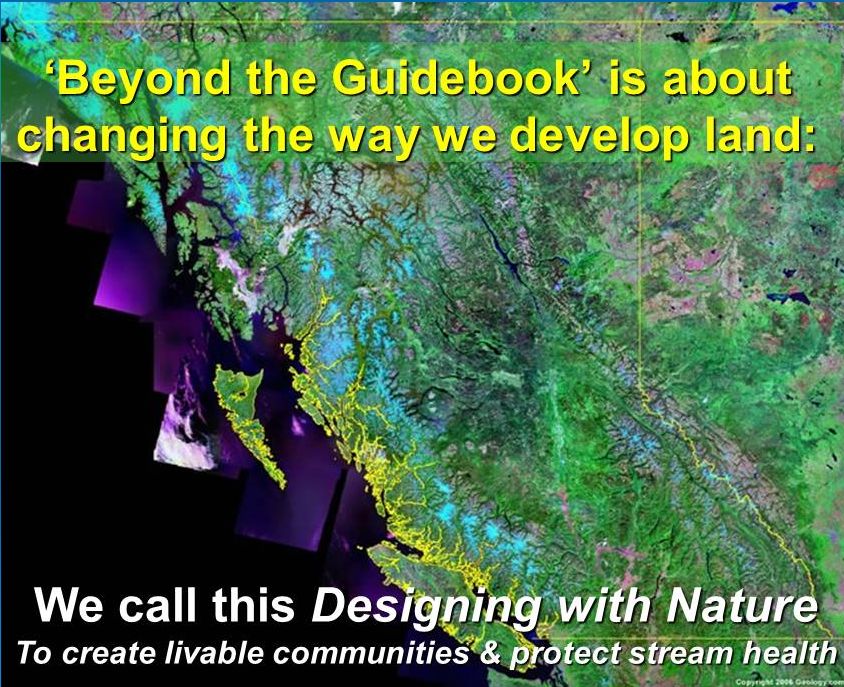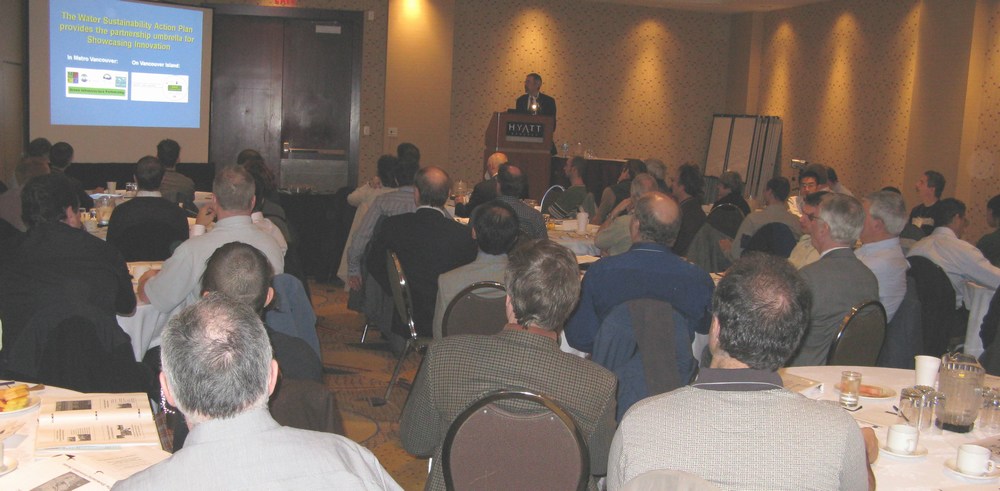2007 APEGBC Seminar served as provincial launch for ‘Beyond the Guidebook Initiative’: “We are now at a point where we can integrate engineering, planning, biology, geomorphology and recreation to influence the greening of the built environment,” stated Dumont
Note to Reader:
Under the umbrella of the Water Sustainability Action Plan for British Columbia, the Green Infrastructure Partnership rolled out Beyond the Guidebook at a Vancouver seminar in November 2007.
Building on the interest in rainwater / stormwater modelling that led to a province-wide series of technical seminars being organized through the continuing education program of the Association of Professional Engineers and Geoscientists of British Columbia (APEGBC), the Green Infrastructure Partnership teamed with APEGBC to deliver a one-day seminar in November 2007 on how to implement ‘green solutions’ that actually protect stream health.
The event was branded as the Beyond the Guidebook Seminar. It provided a forum to mark the formal provincial launch of the Beyond the Guidebook Initiative.

Integration of Rainwater Management & Green Infrastructure
The seminar was structured in three parts to deal with the Why, What and How in going Beyond the Guidebook.
- Part A was titled Green Infrastructure Innovation: On-the-Ground Successes
- Part B was titled Beyond the Guidebook: Applying What We Have Learned to Protect Stream Health
- Part C was titled A Pilot for Beyond the Guidebook: City of Surrey’s Fergus Creek Watershed Plan
Released in June 2007, “Beyond the Guidebook” refers to a runoff-based approach to drainage modeling that connects the dots between source control evaluation and stream health assessment.
The seminar also enabled the Green Infrastructure Partnership to report out on provincially funded programs and tools that are being developed and implemented through partnerships.
To Learn More:
To access a set of stories posted on the Convening for Action community-of-interest, click on Beyond the Guidebook Seminar.
To download a copy of the agenda, click on Seminar Program; and to download a copy of the program objectives, click on Seminar Learning Outcomes.

Seminar attracted a province-wide audience
“The response by the engineering community and others to the 2007 Beyond the Guidebook Seminar was overwhelming, and came as a welcome surprise,” stated Paul Ham, Chair of the Green Infrastructure Partnership, and General Manager of Engineering at the City of Surrey.
“The seminar was a month after the last event in the 2007 Showcasing Green Infrastructure Innovation Series. The goal of the series was to share green infrastructure approaches, tools, experiences and lessons learned as an outcome of designing with nature. As a logical next step, the seminar created a learning opportunity to help practitioners move from awareness to action.”

Interest in the Emerging Regulatory Framework
 Attendance was capped at 72 and there was a waiting list. “We were at capacity two weeks before the event. If we had the option to switch to a larger venue, we would have filled it,” addED Kim Stephens, the seminar moderator and the Program Coordinator for the Action Plan,
Attendance was capped at 72 and there was a waiting list. “We were at capacity two weeks before the event. If we had the option to switch to a larger venue, we would have filled it,” addED Kim Stephens, the seminar moderator and the Program Coordinator for the Action Plan,
“We squeezed as many people as we could into the room,” continues Stephens, “Clearly, there is a strong practitioner interest in learning more about rainwater management and green infrastructure, and understanding the emerging regulatory framework.”
Although the majority of attendees came from Metro Vancouver and the Fraser Valley, the seminar attracted a province-wide audience. There was a large contingent from Vancouver Island. Attendees also came from as far away as Prince George and the Okanagan.

A Transformational Event?
Kim Stephens provided this perspective on what he believes was accomplished by the seminar: “We started the day with high expectations that the Beyond the Guidebook Seminar would prove to be a transformational event, and we exceeded those expectations as the day unfolded.
“Further, my prediction is that this event will become part of our green infrastructure folklore, much as the 2005 REAC Consultation Workshop and the 1997 Union of BC Municipalities focus group workshop were defining moments in moving British Columbia down a pathway that led to the Beyond the Guidebook Seminar.”
“It is the telling of the story about an event that takes on importance in moving practitioners from talk to action,” added Stephens, “A key is that those who were there come away inspired and start doing things differently in their day jobs as a result of what they learned by being part of the moment.”

Where Science Meets Analysis
At the Beyond the Guidebook Seminar, Jim Dumont explained why two rainfall-runoff simulation tools have been merged to create a decision support tool that integrates the site with the stream and the watershed. Jim Dumont has been designated by the British Columbia Inter-Governmental Partnership as its Engineering Applications Authority.
Jim Dumont’s presentation was organized in four parts, He explained why the Water Balance Model and QUALHYMO have been integrated, and what this integration will accomplish.
Beyond the Guidebook Connects the Dots
Stormwater Planning: A Guidebook for British Columbia set in motion a chain of outcomes that has resulted in British Columbia being recognized internationally as a leader in implementing a natural systems approach to rainwater management in the urban environment.
 “Beyond the Guidebook takes the Guidebook to the next level of evolution”, stated Jim Dumont at the beginning of his presentation. The Guidebook pushed British Columbia in a direction. But it is a guidance document, not a design manual.
“Beyond the Guidebook takes the Guidebook to the next level of evolution”, stated Jim Dumont at the beginning of his presentation. The Guidebook pushed British Columbia in a direction. But it is a guidance document, not a design manual.
“Now that practitioners are becoming comfortable with what ‘rainfall capture’ means in practice, local governments and the development community are in a position to turn their attention to what is an achievable outcome that makes sense and results in net environmental benefits at a watershed scale.
“To help engineers in particular go Beyond the Guidebook, we have developed an analytical methodology that connects source control evaluation with stream health assessment.
“Through implementation of “green infrastructure” policies and practices, the desired outcome in going Beyond the Guidebook is to apply what we have learned at the site scale over the past five years…so that we can truly protect and/or restore stream health in urban watersheds.”
Downloadable Document:
To download a document that provides a technical overview of the considerations that shaped model integration, click on Beyond the Guidebook – Why the Water Balance Model Powered by QUALHYMO.
The document incorporates the presentation slides developed by Jim Dumont; they are complete with explanatory comments made by Jim Dumont at the Beyond the Guidebook Seminar.


